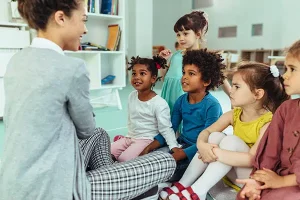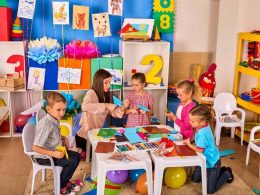Introduction
Choosing the right child education center means finding a place where your child can grow in every way—academically, socially, and emotionally. A strong curriculum guides this growth, balancing play, discovery, and structured lessons. In this article, we will explore the comprehensive curriculum of child education centers. You’ll learn about core subjects, enrichment activities, social-emotional learning, assessment methods, and modern teaching approaches. By the end, you’ll understand how these centers prepare children for success in school and in life.
Rise of Comprehensive Curriculum at Child Education Centers
In recent years, child education centers have shifted from play-based activities alone to well-rounded learning plans. These curricula bring together reading, math, art, music, and physical play in a balanced way. Educators design daily schedules that blend academic lessons with hands-on projects and social games. Parents now expect centers to prepare children not only for school but also for life skills like teamwork and problem solving. This rise reflects a growing belief that young learners need a strong foundation across many areas, not just one.
Benefits of a Comprehensive Curriculum
A broad curriculum helps children grow in all key areas—intellectually, socially, and emotionally. When kids explore different subjects, they discover what excites them and build confidence. Group activities teach sharing, listening, and respect, while projects in art or science boost creativity and critical thinking. Regular routines give children a sense of security, helping them feel ready to learn each day. Overall, this approach lays a solid base for future school success and happy, well-adjusted kids.
Role of the Curriculum in Early Learning
The curriculum acts as a roadmap for teachers, guiding lesson plans and classroom activities. It ensures every child gets time for language, numbers, physical play, and creative arts. By following clear goals, educators can track progress and spot areas where a child might need extra support. Daily themes—like “Our Neighborhood” or “Seasons of the Year”—tie lessons together in a meaningful way. In this role, the curriculum brings structure but still leaves room for fun, discovery, and child-led exploration.
Core Academic Domains
1. Language and Literacy
Early reading and writing form the foundation for later learning. A quality curriculum includes:
- Phonemic Awareness: Games that teach sounds and letters.
- Story Time: Interactive read-aloud sessions to build vocabulary.
- Emergent Writing: Tracing, drawing, and simple sentences to develop fine motor skills.
Teachers use songs, rhymes, and puppet shows to make language fun. They gradually introduce letter formation and reading comprehension through guided books and group activities.
2. Mathematics
Math in early years focuses on hands-on exploration:
- Counting and Number Sense: Using blocks or beads to count up to 20 and beyond.
- Shapes and Spatial Skills: Puzzles and building activities that teach geometry basics.
- Patterns and Sorting: Grouping objects by color or size to understand classification.
Centers use manipulatives—like counters and measuring tools—to make abstract concepts concrete. Story problems and math games help children see math’s role in everyday life.
3. Science and Discovery
Science sparks curiosity about the world:
- Nature Exploration: Outdoor walks to observe plants, insects, and weather.
- Simple Experiments: Mixing colors, watching seeds sprout, or building volcano models.
- Sensory Play: Sand, water, and textured materials to explore properties like wet/dry and soft/hard.
Teachers guide children to ask “why” and “how,” introducing basic scientific vocabulary and the concept of a scientific method: question, observe, and conclude.
4. Social Studies
Even young learners begin to understand community and culture:
- My Family and Me: Sharing family photos to learn diversity and respect.
- Community Helpers: Role-play activities as doctors, firefighters, and teachers.
- Global Awareness: Simple maps and stories about life in different countries.
Through dramatic play and group discussions, children start to see their place in a larger society and learn values like kindness and cooperation.
Enrichment Activities

1. Creative Arts
Arts give children a way to express feelings and ideas:
- Drawing and Painting: Open-ended art time with various media—crayons, watercolors, and chalk.
- Music and Movement: Singing, dancing, and playing simple instruments to build rhythm and listening skills.
- Drama and Role Play: Puppet theaters and dress-up areas for imaginative storytelling.
Creative arts also support fine motor development and hand-eye coordination.
2. Physical Education
Active play supports health and gross motor skills:
- Outdoor Play: Climbing structures, slides, and tricycles to strengthen muscles and balance.
- Group Games: Tag, relay races, and ball games to teach teamwork and following rules.
- Yoga and Stretching: Simple routines to build body awareness and calmness.
Physically active children often show better focus and reduce stress.
Social-Emotional Learning (SEL)
A child’s ability to manage feelings and get along with others is as vital as academic skills. SEL lessons include:
- Self-Awareness: Naming emotions through storybooks and emotion charts.
- Self-Management: Learning to calm down with deep breaths or a quiet corner.
- Social Awareness: Practicing empathy by caring for classroom plants or pets.
- Relationship Skills: Guided playdates and group projects to share, take turns, and resolve conflicts.
- Responsible Decision-Making: Simple choices like snack options or classroom helpers to build responsibility.
Regular circle times allow children to share feelings and practice positive communication.
Assessment and Progress Tracking
Child education centers use gentle, ongoing assessments rather than formal tests. Methods include:
- Portfolios: Collections of artwork, writing samples, and photos to show growth over time.
- Observation Checklists: Teachers note skills in areas like counting, letter recognition, and social behaviors.
- Parent Conferences: Twice-yearly meetings to discuss goals, strengths, and next steps.
This approach focuses on individual progress, celebrating milestones instead of comparing children to each other.
Modern Teaching Approaches
1. Play-Based Learning
Play is a child’s work. Centers design areas—like pretend kitchens, block corners, and sensory tables—that encourage exploration and self-directed learning. Teachers step in to extend learning by asking open-ended questions: “What else could we build?” or “I wonder why the ice melted?”
2. Technology Integration
Age-appropriate tech tools enhance lessons:
- Interactive Whiteboards: Touch-screen boards for group games and drawing.
- Educational Apps: Simple apps that teach letters, numbers, or music in short sessions.
- Digital Portfolios: Online platforms for parents to see updates and children’s work instantly.
Technology is used sparingly and always under teacher guidance to support—not replace—hands-on learning.
Parental Involvement
Children thrive when families and educators work together. Centers encourage:
- Home Activities: Simple projects like counting steps or reading a bedtime story.
- Family Workshops: Sessions on behavior strategies, nutrition tips, or art afternoons.
- Volunteer Opportunities: Parents help with reading groups, gardening days, or celebrations.
Regular communication—newsletters, apps, or bulletin boards—keeps parents informed and involved in their child’s learning journey.
Choosing the Right Center
When evaluating curriculums, consider:
- Balance: Look for centers that mix play, structured lessons, and free choice.
- Qualified Staff: Teachers with early-childhood training and ongoing professional development.
- Environment: Bright, safe, and inviting spaces with age-appropriate materials.
- Values: A focus on inclusion, respect, and a love of learning.
- Assessment Style: Personalized progress tracking rather than strict grading.
Visit multiple centers, observe classrooms, and ask about sample schedules to find the best fit for your child.
Challenges in Implementing a Comprehensive Curriculum
Putting together and running such a wide-ranging program can be tough for centers. Teachers need training in many subjects, which takes time and money. Smaller centers may struggle to buy resources like art supplies, science tools, and books. Keeping activities fresh and engaging for different age groups adds planning work each week. Finally, communicating with parents about goals and progress requires extra meetings or reports, which can strain staff when they are already busy.
Future of Curriculum at Child Education Centers
Looking ahead, curricula will become even more flexible and personalized. Digital tools may let teachers adapt lessons to each child’s pace and interests. Programs will likely include more global themes—covering different cultures, languages, and environmental awareness. Partnerships with local libraries, farms, and museums could bring real-world learning into daily plans. As research on early learning grows, centers will update their curricula to match the latest ideas about how kids learn best.
Conclusion
A comprehensive curriculum in child education centers weaves together academic skills, social-emotional learning, and enrichment activities to support the whole child. By focusing on language, math, science, and social studies alongside arts, movement, and technology, these centers create a balanced learning journey. Gentle assessment methods and strong family partnerships ensure each child thrives at their own pace. Modern approaches—like play-based learning and selective tech use—keep lessons engaging and relevant. Choosing a center with a well-rounded curriculum sets children on a path of confidence, curiosity, and lifelong success.










